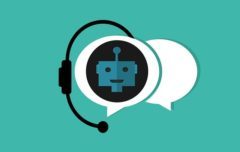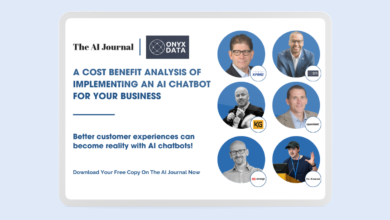
In this article, we’re going to be looking at 10 ways chatbots can be used in businesses today.
Definitions of chatbots
Chatbots, by Oracle’s definition, is a computer programme that simulates and processes human conversation (either written or spoken), allowing humans to interact with digital services as if they were communicating with a real person.
Chatbots can be as simple as rudimentary programmes that answer a simple query with a single-line response, or as sophisticated as digital assistants that learn and evolve to deliver increasing levels of personalisation as they gather and process information.
Oxford Dictionaries define it “A computer program designed to simulate conversation with human users, especially over the internet”.
Now we both know what chatbots are, let’s get into the juicy bits.
Chatbots are increasing
Chatbots are increasingly being used within businesses for a range of different applications and departments.
From placing an online food order to getting your finances broken down to you through Facebook Messenger, the applications are growing at a rapid rate.
A main advantage or capability is that they have the potential to automate business processes while giving instant and accurate answers anytime a customer or team member wants.
The main point is that chatbots are getting smarter and can answer questions in a more detailed manner. As such this is increasing customer satisfaction due to factors such as being able to provide customers information 24 hours a day, seven days a week, 52 weeks a year.
To show how much companies agree with the above, Gartner Research said this year, 2020, consumers will handle 85% of their engagement with businesses without ever interacting with another human being.
We’re going to look at 10 ways chatbots can be used in businesses today while using chatbot applications as examples in today’s post.
But before we jump into the aspects that will help you assess if your business should be using chatbots or not, let’s have a look at some of the current stats, figures, and future predictions of chatbots.
Current stats, figures, and future predictions of chatbots
- 79, 943 chats are fielded by chatbots per month
- 70% of millennials report having a positive chatbot experience
- Over 300,000 chatbots were on Facebook by end of 2018
- 86% of customers believe there should be an escalate to agent option when talking to a chatbot
- Chatbots can cut operational costs by up to 30%
- $8 billion projected business cost saving from chatbots by 2022
- 56% of businesses claim chatbots are causing disruption in their industry
- Nearly a quarter of the world’s population will be using chatbots by end of 2019
- 57% of businesses agree that chatbots deliver large ROI with minimal effort
- 90% of businesses report faster complaint resolution with bots
- 59% of total online chats involve a chatbot
- $3.9 trillion in AI-derived business value growth by 2022
- 75-95% of projected queries to be handled by bots by 2022
- $112 billion projected value of chatbot eCommerce transactions by 2023
These are some impressive stats and should make it clear that chatbots don’t look to be something that will become extinct in the future.
Analyse trends in Big Data
AI has the great capability of analysing massive chunks of data in reasonably small periods of time, just look at how quick AI analysed data for an investment banking firm to give you an idea.
As the chatbot is usually customer-facing and interacting with the businesses customers they can pick up trends in queries and provide detailed analysis on what customers want answering or have access to from the chatbots automated service.
This means important patterns and trends can be highlighted so businesses can enhance their products and services to develop better solutions for the customer. This allows the business the potential to offer better customer service at the same time.
Not only this but it also gives businesses increased ways AI chatbots can be used such as personalising messages to people and filter them towards certain product and service offerings as Harvard Business Review details.
This can have a knock-on effect on lowering the risk for the company as they’re not guessing at what the customer or user wants but are making an informed decision. Giving the possibility of less wasted time and resources going into a development people might not want.
In a Juniper Research Press Release, they suggest that 2.5 billion customer service hours could be saved for businesses and consumers due to chatbots by 2023, that’s a good amount of time saved that can be invested into other areas of business. This leads us onto our next point…
Chatbots decrease customer waiting times
Here’s a fact to start this point off. Chatbots are faster than the fastest customer service agent.
Chatbots have the capability to react to customer messages instantly and combined, this is a massive potential saving for businesses in time. Do you know a human who can answer your query in less than a second?
Chatbots are available 24/7 and have a minimal additional cost to the business. They don’t have any symptoms of fatigue, don’t answer back, don’t need an annual wage, and can answer a query on Christmas day at 04:00.
This gives businesses the ability to offer on-demand customer support, something that would have been a crazy dream 20 years ago.
Although chatbots can’t currently answer all questions or negotiate, such as offering a lower price or knowing how to fix a technical enquiry, they can speed up the process of getting you to the correct person or giving you the correct number to ring so a human can handle your enquiry.
Chatbots have the capability to deal with multiple people at the same time.
So not only do they decrease a customer waiting time, they can decrease a high number of peoples waiting time in one go. Which, again, like a smooth ride, brings us onto our next way a chatbot can be used in business…
No capacity limits lead to reduced customer service costs and waiting time
Going back to the first point where we discussed ways AI chatbots can be used to analyse data and trends.
The reason they can analyse so much data so quickly is that one chatbot can be speaking to multiple people at the same time. So not only can they collect more data, they can collect it in a much quicker manner.

The IBM Watson Conversation platform enabled Autodesk, a global in 3D computer-aided design, to build a customer service chatbot, AVA, which gave the business a 99% improvement in response time: bringing resolution time down to 5.4 minutes from 38 hours.
You might have had the experience where you’re on the phone and you get told what position you are in a queue?
Well with a chatbot you don’t need to wait in a queue. You can get an initial response in less than a second and answers to FAQ’s within 30 seconds, depending on how quickly you type.
With the help of chatbots, businesses can reduce their customer service costs by up to 30 percent while saving both employees’ and customers’ valuable time.
Customers don’t have to wait for an agent and can free up agents for more challenging work and answer up to 80% of routine questions.
This in turn, as you can imagine, improves customer experience with that company as they can deal with a higher quantity of customers, or potential customers, in an instant manner.
Usually, when you have good customer experience, you’re open to shopping with that business or using that provider again.
Now let’s look at ways AI chatbots can be used in predictive analytics to enhance a businesses customer service. Enhanced customer service with lower costs? Sounds like a good business strategy.
Improve customer retention and experience through predictive analytics
You’re probably seeing by now ways AI chatbots can be used to improve customer experience through the points discussed. And from improved customer experience comes improved customer retention.
IBM reported that in an average six-minute human to human customer service call 75% of the time is spent doing manual research, while only 25% was devoted to customer interaction.
So, to get to the answer, most of the time is the person looking up a person’s details and assessing how to answer their question in the best way.
But with a chatbot, the AI system can get that information and relay it instantly. Plus, you don’t have to sit around with your phone on hold while you wait in the queue to get through to an advisor.
Thanks to predictive analytics, ways AI chatbots can be used include being able to predict what a business’s customer is looking for by looking at patterns of customers and analysing this for future decisions.
Predictive analytics could be a huge opportunity for businesses in the future as it has the potential to resolve customer service issues before they arise.
Massively helping with lowering the risk of customer complaints while allowing for huge upside potential regarding customer satisfaction and retention.

Example of predictive analytics in action
Imagine you’re shopping online, and you can’t find an item you’re looking for or the relevant information which is holding you back from purchasing the item and becoming a customer.
Predictive analytics could notice your customer journey by machine learning from previous customers and make a suitable suggestion or give you the information before you even need to ask.
So, the product you were looking for is now instantly shown to you. If you had a high buyer’s intent when searching for the product and you’re now made aware it’s available, this could lead to a purchase and in turn lowers the business’s customer abandonment rates whilst reducing customer queries and enhancing customer experience and willingness to buy again.
Allow members of staff or teams to make better-informed decisions
Thanks to improvements to network and storage technology we’ve witnessed the birth of Big Data, giving more ways AI chatbots can be used.
This technology allows us to analyse human decisions and when combined with machine learning and deep learning, the results can be exceptional.
One of these results being businesses and humans can interpret data to make a better-informed decision.
As Hackernoon notes, collected data is useless without being able to analyse it.
SAP has an application called HANA which can deliver a 575% five-year ROI thanks to the way it can increase innovation. And innovation can come from better questions, better answers, and as a result, better decisions.
Applications like HANA ways AI chatbots can be used across a variety of departments within a business such as advertising.
You can give an AI system all your advertising or marketing data and it will figure out what the best campaign was and what the highlights were.
Allowing you to do a more informed advertising or marketing campaign next time as you know what worked and what didn’t.
Tenfold note that AI modelling and situation techniques enable reliable insight into your buyer personas and can predict consumer behaviour. A chatbot can get this data and record these conversations for future data analysis.
Teams can then use this data a chatbot has got from the customer, interpret it, and make a better decision about what a customer or group of customers might be interested in or might need help with etc.
An example would be knowing what the most asked questions were for a festive period, such as Christmas, where the year before. Pretty nifty, eh?
Can act as personal assistants to members of staff or teams
A team using a chatbot can get them to act as personal assistants and simplify their tasks. Such as sending team reminders of when to hand in a monthly report or telling the accounting team when certain fixed costs need to be paid.
One of the ways AI chatbots can be used as personal assistants is down to the capability that they can machine learn an employee’s actions and what it’s doing and then suggest automation solutions.
This might include what meetings the team should be going to, what leads they should contact, what tasks they should do next, get payments made automatically, just to name a few of the endless options.
Individuals within a team might be struggling to find a certain document or struggling to analyse certain data. Ask that question to a chatbot and you can have that answer instantly, in some cases.
You may have seen the advertisements for the financial AI assistant, Plum? Well, that’s a chatbot that can show you how much your spending, what your current balances are, and how to suggest ways on how to save.
Except in a business situation you might be at a meeting and need to know what your sales were in a certain quarter, whip out your phone, ask your chatbot, and bam, you’ve got your answer almost instantly.
Towards Data Science highlights how you can get travel tips, fashion recommendations, and food ordered all through a chatbot or virtual assistant. So, you and the team could all tell your chatbot what food you want for the team meeting and it will order it up for you.
Like how a chatbot can improve customer experience, it could be suggested that a chatbot improves an employee’s experience.
Example of a chatbot as a personal assistant
Let’s say you work for a large multi-national organisation. The HR team due to looking after so many team members can sometimes have large delays in getting back to inquiries that come in from all over the world.
The HR team announces they are installing a chatbot to deal with frequent enquiries due to the large volume. You ask the chatbot a certain question such as ‘how much annual leave do I have left?’
The chatbot uses the internal data it has and gives you an instant response saving you waiting time and allowing you to book that awesome holiday deal you want to book. Not only has it saved you and the HR team time, but also save you some money on your holiday. Talk about a win-win.
Can automate business-to-business applications
There’s a growing amount of companies that are offering automation solutions for what used to be timely admin work across lots of different departments from sales to marketing to accounting.
There is an increasing amount of companies that are creating ways AI chatbots can be used in communication and task automation to keep you on track with meeting your business goals. Examples of these companies are Asana, Slack, and Teamwork.
When using Slack within a team, if a team member sets their status to away, the person trying to message them will get an automated response from a slack chatbot asking if they want to send a push notification to them or not, usually done if it’s a high priority message.
BotCore is a company who sells bots to help organisations internal teams and can be used across marketing, sales, procurement, and HR among others.
LinkedIn’s 2017 global survey identified that hiring can take anywhere from a few days to four months depending on the role.
BotCores bots can be used within recruitment for example where you can get the bot to speak to initial candidates, these can record this data, and then send it on to the recruiters with a detailed summary of the conversation, the stats, and whether the candidate is suitable to be taken to the next stage.
As you can imagine, having a chatbot that can streamline this process can reduce a company cost in time and money quite significantly by qualifying a high intake of candidates and shortlisting the most suitably matched.
We’re going to use another example, this time for a chatbot application in the accounts department.
A business can set up a chatbot that can be supplier focussed instead of customer focussed. This way, as Forbes also mentions, the chatbot will be able to do certain tasks and answer queries instantly including getting invoices, making payments, get an order summary, and more.
So imagine how much that could help a businesses accounts team. If the business is reasonably large, it could cut the costs as they wouldn’t need to hire someone for finance admin.
Can generate and assign leads
Following on from the previous point, due to chatbots automating B2B applications, they can generate the leads by getting customers to fill in their details, and at times, know what the customer is after in high detail.
This can then be sent back to a customer relationship manager (CRM) tool and uploaded to see by the sales teams.
More than that, providing the CRM tool is programmed to filter for certain sales team members or divisions, i.e. food, manufacturing, finance, the leads can be sent through to the person or team that deal with those leads, creating an automated and simplistic process.
Now, these are ways AI chatbots can be used to increase not only business efficiency but also turnover and profits. Don’t think many business owners would be against that.
In a small organisation, something like this might not be needed, however, if you’re in a big multi-national organisation, this could stop a lot of delays with starting the lead process and getting in touch with the potential customer.
V-Soft Consulting explains how a B2B chatbot can study the visitor’s interactions, create behaviour analytics, and create a profile on the visitor based on the probability of getting the lead to a customer.
To give an idea of how many companies are using chatbots and AI to automate the lead generation process, Gartner reported that by 2020, 30% of all B2B companies will employ artificial intelligence to augment at least one of their primary sales processes.
Let’s have a look a hypothetical situation to understand how this technology from a chatbot helps.
Example of generating and assigning leads
Put yourself in this hypothetical situation where you’re a salesperson at a multi-national business. This situation is also relatable to point five – allowing members to make better-informed decisions.
You log on to your CRM system to three new lead that has recently come through and been assigned to you.
You look at the leads, the first profile has a 25% probability of becoming a lead, second has a 50% probability of becoming a lead, and the third has a probability of 75% of becoming a lead.
Now you’ve got this data, do you think it will change how you prioritise what lead to contact first and what approach you take with the leads? I know it would for me.
Can help a business expand into global markets
Thanks to having AI technology, chatbots can communicate in multiple languages with ease. Imagine being able to learn a new language instantly, that would be handy, right?
Well, a chatbot can start answering queries about a business’s products and/or service in the countries native language and can capture leads for that country without needing to send representatives to that country.
This, of course, lowers the barriers to entry in that country, the risk involved, and costs of hiring native speaking representatives thanks to the bot being able to translate the message so the team understand the request of the lead.
Additionally, it’s a good way to test if the country is interested in a business’s product or service.
As we mentioned in the first point, AI’s ability to analyse trends in big data, it can help us with geographic market research and what strategy would be best to use or if there is even any data to suggest the company should expand to a selected region/ countries market.
If a business is global, the chatbot can help them improve customer service for that country and scale-up local operations by solving local faqs instantly.
Digital Dougnut notes how effective chatbots can be for foreign regions by being available 24/7 and can communicate in the native language.
For the customer this may mean no more ringing a call centre in a foreign country, waiting in a 30-minute queue, to find out no one speaks their language, for what is a frequent easy-to-answer question.
Decrease, prevent, and stop fraudulent activities
Although people question the integrity of a chatbot and if it actually will keep personal information private, as a CSO article outlines, when built correctly they can provide more in the way of privacy and protection of the user’s details than a human operator.

Chatbots are becoming increasingly better at tracking fraud, and more specifically, identity fraud, in real-time.
One of the ways AI chatbots can be used is thanks to the fact they can record data and, unlike humans, don’t forget this data further down in the conversation as AI Business mentions.
So, if someone trying to commit fraud gets an answer right initially but later in the question’s answers incorrectly, the chatbot will flag this and start a security check. Massively helping businesses reduce probabilities of fraud getting past undetected or fraudulent incidents happening in the first place.
People will never be 100 percent reliable, whether it’s from breaching security information, turning up to work, or telling the truth about a certain situation so they don’t get in trouble. Compared to chatbots who are reliable and do exactly what they’re programmed to do, making them a great option for storing important and private customer or business data.
There are chatbots that now use facial recognition, like how the iPhone can be unlocked by looking at the screen. Mobile banking apps such as HSBC have started using this already meaning you don’t have to enter a passcode; you just must look at the screen when prompted.
As virtual assistants become able to control more applications through IoT, they too will need to ensure they are equipped to stop and prevent fraud.
Virtual assistants such as Amazon’s Alexa, Google’s Google Home, and Apple’s HomePod can control smart products including TVs, fans, coffee machines, lights, while also being able to send texts, make calls, play audiobooks, give you a news breakdown, and much more.
However, it’s important to note that although chatbots can help decrease, prevent, or stop fraud, they are also subject to being what is called ‘hacked’ or infected with malware.
This can cause an increased risk to customers data if it happens and have a big impact on a companies brand image, as Inform Communications warns when looking at the risks and vulnerabilities of chatbots in today’s world.
For this reason, we strongly recommend that if you, or your business, do use a chatbot that you get it installed and tested by professionals before using.
What’s your opinion?
Have you used a chatbot and not had a great experience? Perhaps you think chatbots are a trend that won’t last? Or maybe you have an idea for how we can better use chatbots? Do you have more ways AI chatbots can be used in businesses? We always love to hear your view so be sure to let us know!
Be sure to leave a comment, like, and subscribe to make sure you’re the first to know when we’ve released new content. Until next time.





